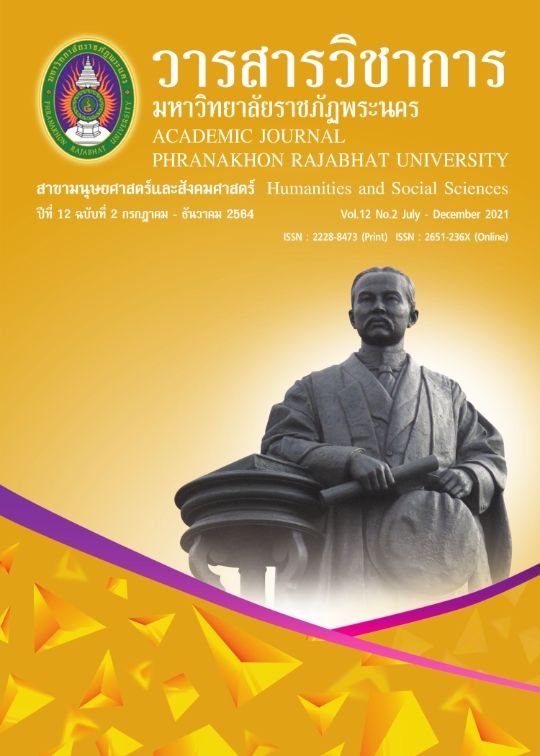THE USE OF METAPHORICAL APPROACH IN LEARNING CHINESE VOCABULARY OF GRADE 11 THAI STUDENTS
Keywords:
Metaphorical Approach, Chinese Vocabulary Learning, Grade 11Abstract
The objectives of this study were to compare grade 11 Thai students’ achievement in learning Chinese vocabulary before and after using Metaphorical Approach and to investigate grade 11 Thai students’ attitude towards using Metaphorical Approach in learning Chinese vocabulary. A group of 20 Thai students was chosen by applying simple random method. The study adopted Mixed methods. Four lesson plans which lasted 100 minutes were developed and taught for 8 sessions within the time period of two months. The quantitative data was collected through achievement tests (Pre-test and Post-test) and questionnaire. The qualitative data was collected through semi-structured interview. The findings revealed that Metaphorical Approach was an effective method to enhance grade 11 Thai students’ learning achievement in learning Chinese vocabulary with the Post-test mean score of 22.05 which was 11.95 higher than the mean score of the Pre-test of 10.10. The data gathered from the questionnaires showed that all items were ranked at the high level. It evidently proved that the students generally held positive attitude towards Metaphorical Approach. The semi-structured interview results indicated that students enjoyed the given lessons, and were satisfied with the class activities.
References
Chen, C. (2019). Education of studying abroad in China, to construct "Double First-Class" Colleges and Universities. Y. Lu (Eds.), Research on China International Education. Beijing, Beijing Language and Culture University Press. 204-214.
Chen, X. (2013). The Study of Teaching Single Chinese Characters with Character-origin Teaching Method. Fujian Normal University. Retrieved from http://cdmd.cnki.com.cn/Article/CDMD-10394-1013307022.htm
Chen, X. (2013). The Study of Teaching Single Chinese Characters with Character-origin Teaching Method. Fujian Normal University. Retrieved from http://cdmd.cnki.com.cn/Article/CDMD-10394-1013307022.htm
Chen, Y. (2018). Rhetoric skills such as "upside-down", "similarity", "multi-character", "sentence", "aliteration" and other rhetorical techniques in waka——Taking the works in "Hyakunin Isshu" as an example. Retrieved from: https://xueshu.baidu.com/usercenter/paper/show?paperid=134f0tx0ws4q0aa0q61r0tw0fn035306&site=xueshu_se
Deignan, A., Gabryś, D., & Solska, A. (1997). Teaching English metaphors using cross-linguistic awareness-raising activities. ELT journal, 51(4), 352-360.
Fernandes, S., Querido, L., Verhaeghe, A., Marques, C., & Araújo, L. (2017). Reading development in European Portuguese: relationships between oral reading fluency, vocabulary and reading comprehension. Reading and Writing, 30(9), 1987-2007.
Hou, Y. (2012). Research on the Current Situation and Development Approaches of Chinese Teaching in Southeast Asia Region. Around Asia, 12 (5), 51-54.
Lessard-Clouston, M. (2013). Teaching Vocabulary. Virginia, TESOL International Association.
Li, J. (2007). Historical Review of Teaching Chinese as a Foreign Language. International Chinese Education.
Li, Y. (2005). The Strategies of Learning Chinese Vocabulary of Thai Students. Yunnan Normal University.
Liu, J. (2016). Role of Vocabulary Levels Test (VLT) in Chinese undergraduate students’ comprehension of textbooks. Journal of Language Teaching and Research, 7(2), 364-369.
Liu, X. (2010). On the relationship between English learning method and psychology. Meili Zhongguo, 119, 276-277.
Liu, Z. (2019). The concept of vocabulary composition and modern Chinese vocabulary teaching. Retrieved from http://lib.cqvip.com.ezproxy.claridy.com.cn:20480/Qikan/Article/ReadIndex?id=7002811475&info=BcGwTJfX0pji97FJdd6xvVefAvxGf0Vnti6CGh6OSOqSPYblnf4CTA==
McIntosh, C. (Ed.). (2013). Cambridge Advanced Learner’s Dictionary (4th ed.). Cambridge, Cambridge University Press.
Nation, I. (2006). How Large a Vocabulary is Needed for Reading and Listening. Canadian modern language review, 63(1), 59-82.
Olinghouse, N. G., & Leaird, J. T. (2009). The relationship between measures of vocabulary and narrative writing quality in second-and fourth-grade students. Reading and Writing, 22(5), 545-565.
Peng. C. (2016). Exploring Chinese-English Translation Strategies of Simile Metaphors from Text Typology. Doctoral dissertation.
Pichetladarom, C. (2016). A Study on Chinese Learning Strategies of Thai Students. Minzu University of China.
Qin, H. (2006). Rhetoric teaching in TCFL. Yuyan Jiaoxue Yanjiu. 95-97.
State Language Commission. (1988). Common Characters in Modern Chinese. Retrieved from https://www.zdic.net/zd/zb/cc1/
Sun, R. (2015). The Study on Vocabulary of the Textbook “Experiencing Chinese” for Junior School and Suggestions. Chongqing University.
Wang, J. (2016). Cultivation of College Students ‘Intercultural Communication Awareness in the Context of Higher Education Internationalization. Education Teaching Forum,50, 232-233.
Wang, J., & Wu, H. (2002). Vocabulary review strategies of teaching Chinese as a foreign language. Journal of LaiYang Agricultural College (Social Science Edition), 14(1), 93-96.
Wang, J., (2016). Analysis of Translation Strategies of Figurative Rhetoric in Chinese-English Translation. English Square.
Wasik, B. A., Hindman, A. H., & Snell, E. K. (2016). Book Reading and Vocabulary Development: A Systematic Review. Early Childhood Research Quarterly, 37, 39-57.
Webb, S., & Nation, P. (2017). How vocabulary is learned. Oxford University Press. Retrieved from https://www.tesl-ej.org/wordpress/issues/volume23/ej92/ej92r3/
Wu, H. (2013). A Study on the Classroom Chinese Teaching Strategy in Thai Middle Schools. Jintian, 000(011), 187-188.
Xue, D. (2017). The Study on Zhou Youguang’s Theory of Writing Systems Typology. Hunan Normal University. Retrieved from https://www.ixueshu.com/document/79da8b70f0a1bdba3cd98c1d59598cfa318947a18e7f9386.html
Yang, J., & Cai, L. (2009). A Comparison of the Cultural Connotations of Chinese and French Animal Vocabulary. Times Literature (the second half of the month).
Yang, Y. (2010). Character-Word Relationship in Characters-Centered Teaching. Journal of Chongqing Technology and Business University (Social Sciences Edition), 27(1), 148-151.
Yang, Y. (2020). Chinese Pinyin Scheme under the Perspective of Language Ecology. Journal of Kaifeng Vocational College of Culture & Art, 40(2), 60-62.
Zhang, W. (2014). The Inevitability and Contingency of the Origin and Development of Chinese Characters. Wen Jiao Zi Liao, 36, 158-159.
Downloads
Published
How to Cite
Issue
Section
License
Copyright (c) 2021 Academic Journal Phranakhon Rajabhat University

This work is licensed under a Creative Commons Attribution-NonCommercial-NoDerivatives 4.0 International License.
"บทความวิชาการในวารสารฉบับนี้ ถือเป็นความรับผิดชอบของผู้เขียนเท่านั้น"
สงวนลิขสิทธิ์ตามพระราชบัญญัติลิขสิทธิ์




